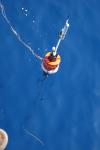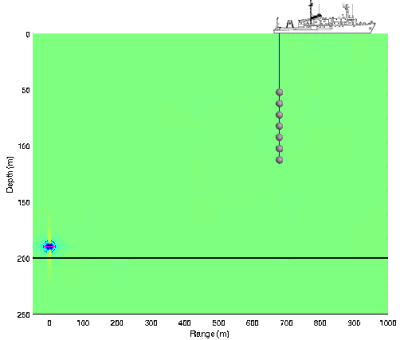|
You are not Logged in! Log in to check your messages. |

|
|
Check todays hot topics |
Web2Project Sign in
SiPLAB products:

Acoustic Oceanographic Buoy (AOB)
The AOB is an integrated system composed of a piece of hardware to be deployed at sea (from a surface ship or aircraft) and a software utility that interfaces with the user at a remote location on real time. The AO-Buoy capabilities are as follows:
- easy to handle system tending to the size, weight and autonomy of a standard sonobuoy
- several depth modulable wideband acoustic and non-acoustic (thermistors, depth sensors, ...) channels
- on the buoy GPS for time and location reference
- on the buoy pre-processing for data reduction and analysis
- fast remote wireless communications for data online monitoring and processing
- online tracking of AO-Buoy position, status and data being acquired
- real time data processing with the following scopes: water column temperature profiling via tomographic inversion, geo-acoustic bottom inversion, sound source detection, localization and tracking and underwater communications in the band up to 16 kHz.
Recent publications:
 Common dolphin's shipping noise risk assessment on the Portuguese coast,
Mar. Pol. Bull, 211 117415 [PDF]
February. 2025.
Common dolphin's shipping noise risk assessment on the Portuguese coast,
Mar. Pol. Bull, 211 117415 [PDF]
February. 2025.
 Influence of Dolphin-Watching Tourism Vessels on the Whistle
Emission Pattern of Common Dolphins and Bottlenose Dolphin, Oceans, Vol.5, 770-784
[PDF] 2024.
Influence of Dolphin-Watching Tourism Vessels on the Whistle
Emission Pattern of Common Dolphins and Bottlenose Dolphin, Oceans, Vol.5, 770-784
[PDF] 2024.
 Search Space Reduction for Localization and Tracking of an Acoustic
Source, Signals, 4 478-488 [PDF]
June 2023.
Search Space Reduction for Localization and Tracking of an Acoustic
Source, Signals, 4 478-488 [PDF]
June 2023.
Featured products:

PAM2py
download zip or github, a Python open source version of the PAMGuide package for Passive Acoustic Monitoring that features the Exchange Data Format (EDF) for facilitated underwater acoustic data sharing and metadata handling. Python allows for a crossplatform licence free processing of raw acoustic data and EDF output. A library of Python routines for EDF data reading and writing are also available. See manual here.